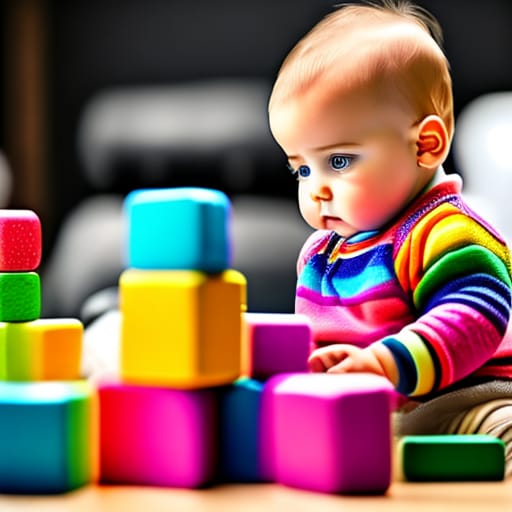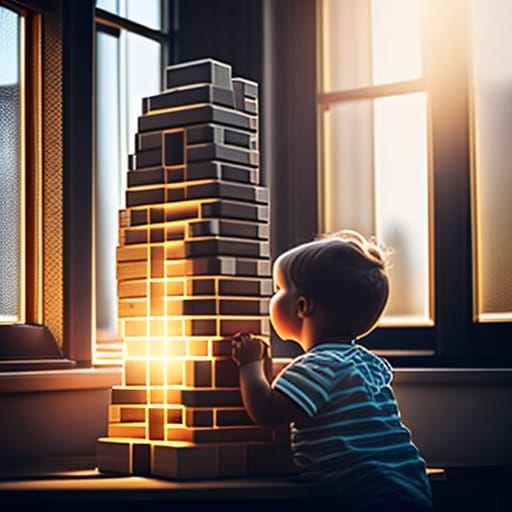Brightly colored blocks of various shapes and sizes have long been staple toys in early childhood classrooms and playrooms around the world. As simple as they may seem, blocks offer numerous developmental benefits for little learners, especially in the areas of language and communication.
For children aged 3 years, block play provides the perfect opportunity to build key language, cognitive, and social-emotional skills that will pay dividends as they grow. Read on to discover why blocks should be an integral part of every 3-year-old’s daily routine and how simple block activities can foster vocabulary, spatial reasoning, and more!
Why Blocks? Examining the Research
Decades of research studies have demonstrated the multifaceted value of block play across developmental domains. But why are blocks such a powerful educational tool specifically for preschool skills and behaviors?
Several factors make block play uniquely supportive during early childhood:
- Blocks allow open-ended creativity and imagination unlike many other toys
- Spatial and mathematical concepts are reinforced organically during block construction
- Fine motor skills develop through grasping and manipulating blocks
- Language and communication growth occurs through description and collaborative building
Additionally, a 2019 study published in the journal Child Development found a link between toddlers’ and preschoolers’ block construction abilities and their math and verbal skills years later in early elementary school.
The research suggests early competency in spatial assembly – arranging 3D blocks purposefully to create structures – lays the foundation for higher-level STEM and language skills down the road. Pretty impressive for a simple box of wooden blocks!
Block Play Stages and Development
Children’s block abilities progress through predictable stages during the 3 to 4 year age range:
Exploratory Stage
First, around age 2, kids enter an exploratory phase involving basic sensory exploration and simple stacking or lining up blocks. Key milestones include:
- Recognizing basic block shapes (squares, rectangles, arches)
- Identifying colors and sorting by attributes
- Stacking 4-6 blocks vertically
Manipulative Stage
By age 3, children transition to the manipulative stage where they start to construct simple enclosures and patterns. Key achievements include:
- Building train or fence-type patterns
- Understanding position words like “under”, “next to”, “behind”
- Balancing blocks horizontally to form enclosures
Constructive Stage
Finally, around age 4, kids enter the constructive phase where they can plan elaborate structures and expansions. Complex skills include:
- Incorporating symbolic meaning into constructions (e.g. “This is a zoo.” “I made a castle.”)
- Communicating and explaining the building process
- Resolving structural problems that arise
Understanding these benchmarks helps parents and teachers recognize the rapid growth happening through children’s block play. It also suggests fun, developmentally-appropriate activities to introduce as kids build key competencies.
Nurturing Communication and Language
One major appeal of blocks ties to their power to strengthen children’s communication abilities, including:
- Expanding vocabulary knowledge
- Building narrative and explanatory speaking skills
- Improving conversational interactions
This begins during the exploratory phase as children start learning new words simply by playing with blocks. Common examples include:<div class=”table-wrapper”>
| Vocabulary Type | Term Examples |
|---|---|
| Colors | red, blue, green, yellow |
| Shapes | square, rectangle, triangle, circle, arch, ramp |
| Sizes | big, small, large, tiny, tall |
| Textures | smooth, rough, bumpy, scratchy |
Labeling blocks with correct vocabulary during play reinforces early language. Asking focused questions also builds descriptive understanding over time:
- “What color is that block?”
- “Do you have a smooth piece or a bumpy piece?”
- “Can you find two big rectangle blocks?”
As children progress developmentally, block play elicits richer vocabulary and conversational practice. Constructing an elaborate zoo with arches, towers, and enclosures involves using more advanced position words, sizes, pronouns and part directions:
- “Place the long blue block behind the arch.”
- “Hand me that tiny yellow cylinder piece.”
- The giraffes go inside their pen next to the lions.”
Encouraging children to describe their process out loud grows narrative capacities too. After finishing a structure, open-ended questions allow kids to explain key elements in their own words:
- “Tell me about what you built here.”
- “How did you make this tall tower stay up?”
- “Why did you choose to use mostly red blocks?”
This narration process stimulates language areas of the brain beyond just labelling objects. Over time, it strengthens skills like formulating WH- questions, using pronouns accurately, and expressing complex ideas verbally – abilities essential for future reading, writing, and learning.

Observing Development Through Block Play
For parents and early childhood professionals, block play also offers a peek into each child’s developmental progress. You can discover fine details about kids’ growing language and cognition by observing their construction style, communication patterns, and chosen vocabulary.
Documenting key behaviors during play allows you to note emerging milestones as well as potential lags that may require intervention. What should you look for? Examples include:
- Precision of constructions – Are structures balanced and integrated vs random stacking? This reflects spatial reasoning.
- Problem-solving language – Does the child vocalize solutions when structures fall? This shows cognitive flexibility.
- Peer interactions – Does the child engage peers collaboratively or mostly parallel play solo? This demonstrates social skills.
- Vocabulary used – What descriptive words emerge during play? Does this align with developmental expectations?
Tracking observations over time creates an informative snapshot of each child’s growth trajectory. It can also reveal early red flags of potential issues requiring support.
For instance, if an assessor overhears limited vocalizations and repetitive solitary lining up of pieces from one 3 year old, it may reflect lagging communication and interaction capacities compared to peers. customized assistance.
Creative Block Centre Ideas and Activities
Dedicated block play zones with plentiful materials encourage purposeful building and richer learning. Although blocks generally captivate kids intrinsically, teachers can spark added enthusiasm and maximize developmental gains using strategic enhancements.
Fun theme additions like images of landmarks, play people figurines, and toy cars help spur imaginary constructions bursting with language. Building around visual cues from pictures of the Eiffel Tower or Great Wall of China immerses kids in pretend travel while reinforcing vocabulary about key global sites.
Loose parts like craft sticks, beads, pompoms can also increase cooperative construction and descriptive exchanges. As kids negotiate design elements, encourage them to use spatial terminology, sizes, colors and shapes in their discussion.
Finally, place permanent dictionaries or communication boards near the blocks displaying rich vocabulary terms, WH question words, pronouns, actions, and feelings. Having quick visual references empowers kids to immediately incorporate new words independently during dramatic block play, enriching language each session.
Supporting Crucial Cognitive Skills
It likely comes as no surprise that block play assists more than just communication abilities. Construction toys have also proven exceptionally valuable for building other cognitive capacities vital to school readiness and academic success.
Several key examples include:
Mathematical Skills – Counting pieces needed, recognizing block attributes, and categorizing shapes boost early numeracy. Studies demonstrate block play during preschool strongly predicts later math achievement.
Scientific Reasoning – Balancing irregular structures develops intuitions about stability, gravity, and physical transformations valuable for the sciences.
Executive Functions – Planning constructions, solving problems when they collapse, and controlling impulses to destroy peers’ buildings strengthens crucial self-regulation skills for focusing and learning.
Creativity – Open-ended block play sans structured rules nurtures flexible thinking, imagination, and innovation key for arts participation.
Indeed, multiple analyses note such cognitive links persist over time. In one study tracking student progress, teens who frequently played with blocks as toddlers still showed heightened math, science, and creative abilities at age 14 relative to peers lacking block exposure.
Clearly, failing to provide young kids with sufficient constructive play shortchanges their future potential across many intellectual dimensions, not just language advancement.
Concerns for Children with Developmental Issues
While every young child thrives better with blocks, they serve particularly vital adaptive purposes for those facing developmental obstacles or delays. For example:
Children with speech/language disorders often struggle to communicate ideas verbally. Constructing elaborate scenes with blocks allows creative expression beyond speaking limits while strengthening conceptual growth.
Kids on the autism spectrum tend to demonstrate weaknesses with symbolic pretend play. Leveraging blocks’ simultaneous appeal and structure scaffolds social interaction and flexibility through purposeful building.
Caregivers and therapists thus emphasize blocks for building critical language and learning skills in special needs populations from very early ages. Though faces challenges, customized block play interventions tailored to each child regain developmental ground and lift future capability.

Final Takeaways: Let Imaginations Soar!
- Research clearly demonstrates block play uniquely advances language, cognitive, creative, and social growth in early childhood. No preschooler’s development is complete without ample constructive play.
- Enrich block areas through visual aids, loose parts, communication tools, and theme elements to spur purposeful building and descriptive dialogue essential for academic readiness.
- Observe children’s block constructions, interactions, and vocabulary closely over time to track developmental progress and potential issues requiring additional support.
- All kids benefit hugely from block play, but focused block interventions help regain developmental trajectories for children facing learning disorders or language delays even more substantially.
At the end of the day, blocks timelessly captivate young kids while building crucial capacities through joyful hands-on learning suited perfectly to their developmental stage. Yet their benefits extend far beyond preschool years to support higher learning and innovation throughout life when constructive play immersion establishes essential foundations.
So next time your 3-year-old gets lost building elaborate structures while babbling excitedly about their fantastical emerald castle or rocket to the moon, don’t be tempted to redirect their attention. Instead, grab some blocks yourself to join in the construction fun while seizing a prime opportunity to nurture communication abilities through descriptive back-and-forth exchanges. Don’t underestimate the power of seemingly simple blocks for launching little learners toward future success!
Frequently Asked Questions
What are the main benefits of block play for my 3-year-old?
Block play uniquely advances language, cognitive, creative, and social growth in early childhood. Key perks include expanding vocabulary, improving communication skills, building spatial reasoning and fine motor skills, strengthening problem-solving abilities and mathematical concepts, boosting focus/self-regulation, and nurturing imagination.
What block play stages should I expect at age 3?
By age 3, most kids have moved beyond basic exploration of blocks into the manipulative stage. Key milestones are constructing simple enclosures, balancing blocks horizontally, understanding positional concepts like “under” or “behind”, and starting symbolic meaning like “here is the barn for my farm”.
How do blocks support language development?
Constructing elaborate structures, describing the process, and pretending together exposes children to valuable spatial, color, size and texture vocabulary. Negotiating designs strengthens conversing back-and-forth cooperatively. Explaining completed buildings grows narrative capacities. This language growth fuels future reading and writing success.
Should I be actively participating in my 3-year-old’s block constructions?
Absolutely! Joining play without taking over allows you to model rich descriptive vocabulary and positional phrasing. Asking open questions about their process builds explanatory speaking skills too. And supporting frustration when structures collapse teaches emotional regulation and problem-solving language valuable for preschool coping.
What developmental issues might block play reveal in my child?
Carefully observing play style over time can reflect developmental progress or lags. Limited symbolic meaning, repetitive solitary lining up of pieces or struggling with balancing stability may signal issues like rigid thinking, fine motor delays or spatial reasoning weaknesses that warrant assessment and support.
How do I optimize my block centre for rich language exposure?
Supply images, loose parts like craft sticks/beads, and references like vocabulary boards. Building around visual landmarks sparks imaginary constructions and new vocabulary connections. Negotiating how to incorporate loose parts strengthens cooperative dialogue. Quick access to words or questions empowers communication independence while playing.
